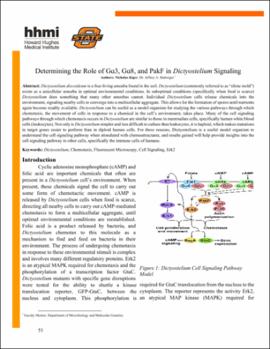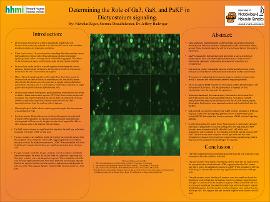| dc.contributor.advisor | Hadwiger, Jeffrey A. | |
| dc.contributor.author | Kiger, Nicholas | |
| dc.contributor.other | HHMI Life Science Freshman Research Scholars | |
| dc.date.accessioned | 2019-07-22T17:02:50Z | |
| dc.date.available | 2019-07-22T17:02:50Z | |
| dc.date.issued | 2019-04-27 | |
| dc.identifier | oksd_hhmi_2019_kiger | |
| dc.identifier | oksd_hhmi_2019_kiger_poster | |
| dc.identifier.citation | Kiger, N., & Hadwiger, J. A. (2019, April 27). Determining the role of Gɑ3, Gɑ8, and PakF in Dictyostelium signaling. Paper presented at the HHMI Life Science Freshman Research Scholars Symposium, Stillwater, OK. | |
| dc.identifier.uri | https://hdl.handle.net/11244/321022 | |
| dc.description.abstract | Dictyostelium discoideum is a free-living amoeba found in the soil. Dictyostelium (commonly referred to as "slime mold") exists as a unicellular amoeba in optimal environmental conditions. In suboptimal conditions (specifically when food is scarce) Dictyostelium does something that many other amoebas cannot. Individual Dictyostelium cells release chemicals into the environment, signaling nearby cells to converge into a multicellular aggregate. This allows for the formation of spores until nutrients again become readily available. Dictyostelium can be useful as a model organism for studying the various pathways through which chemotaxis, the movement of cells in response to a chemical in the cell's environment, takes place. Many of the cell signaling pathways through which chemotaxis occurs in Dictyostelium are similar to those in mammalian cells, specifically human white blood cells (leukocytes). Not only is Dictyostelium simpler and less difficult to culture than leukocytes, it is haploid, which makes mutations in target genes easier to perform than in diploid human cells. For these reasons, Dictyostelium is a useful model organism to understand the cell signaling pathway when stimulated with chemoattractants, and results gained will help provide insights into the cell signaling pathway in other cells, specifically the immune cells of humans. | |
| dc.description.sponsorship | Howard Hughes Medical Institute Science Education Program | |
| dc.format | application/pdf | |
| dc.language | en_US | |
| dc.publisher | Oklahoma State University | |
| dc.rights | In the Oklahoma State University Library's institutional repository this paper is made available through the open access principles and the terms of agreement/consent between the author(s) and the publisher. The permission policy on the use, reproduction or distribution of the article falls under fair use for educational, scholarship, and research purposes. Contact Digital Resources and Discovery Services at lib-dls@okstate.edu or 405-744-9161 for further information. | |
| dc.title | Determining the role of Gɑ3, Gɑ8, and PakF in Dictyostelium signaling | |
| osu.filename | oksd_hhmi_2019_kiger.pdf | |
| osu.filename | oksd_hhmi_2019_kiger_poster.pdf | |
| dc.description.department | Microbiology and Molecular Genetics | |
| dc.type.genre | Research report | |
| dc.type.genre | Presentation | |
| dc.type.material | Text | |
| dc.subject.keywords | dictyostelium | |
| dc.subject.keywords | chemotaxis | |
| dc.subject.keywords | fluorescent microscopy | |
| dc.subject.keywords | cell signaling | |
| dc.subject.keywords | erk2 | |

